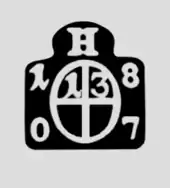Lot (fineness)
A Lot (formerly Loth) was an old unit of measurement for the relative fineness[1] to gross weight in metallurgy and especially in coinage until the 19th century. A Lot was thus a proportion of the precious metal content in a piece of metal.[2] It was used in the four main monetary systems of Germany: Austrian, South German, North German and Hamburg.[1]
| Lot | |
|---|---|
| Unit system | German imperial |
| Unit of | number (quotient or fraction) |
| Symbol | |

The lot was defined as the sixteenth part of a Mark.[3][4] For example, in silver, the total weight was divided into 16 (proportional) Lots until about 1857, according to which a "12-Lot" silver alloy (750 silver) contained 12/16 = 3⁄4 or 75% by weight of silver and 25% of another metal (usually copper). A 14-Lot silver alloy (14⁄16), on the other hand, corresponded to 875 silver. For refinement, a Lot was further divided into 18 grains.[4] Thus 14 Lots, 4 grains fine then correspond to a fineness of 888.89 ‰ = (14 + 4 / 18) / 16 = (252 + 4)/288, i.e. 256/288 grains.
The German proportional measure, the Lot, was finally replaced on 1 January 1888 in the German Empire by the proportional measure, permille (thousandths).[2]
See also
- Carat for gold.
References
- _ (1896), The Journal of Political Economy, Vol. 4, p. 190.
- Geissler, Ewald and Josef Moeller (1886). Real-Encyclopädie der Gesammten Pharmacie, Volume 9, p. 264.
- Bringucci, Vannoccio (1990), Pirotechnia. New York: Dover. p. 209.
- Kelly, Patrick (1821), The Universal Cambist and Commercial Instructor. Vol 1. 2nd edn. London. p. 169.